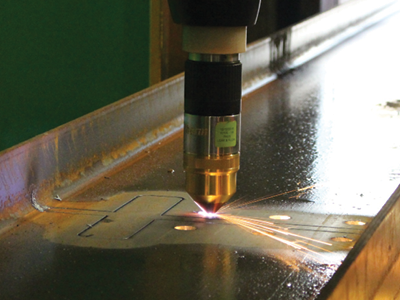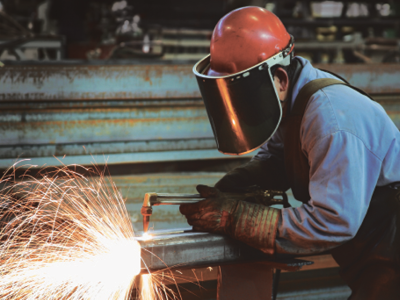Oxy-Fuel Versus Plasma Cutting: Choosing the Right Process for Your Cutting Application
When it comes to cutting metal, several processes are available today. Two of the most widely used cutting technologies are oxy-fuel and plasma. Choosing whether to go plasma or oxy-fuel for your steel cutting job depends on a number of factors, including the type of alloy, its thickness and any specific requirements for tolerance and cut quality.
Both oxy-fuel cutting and plasma cutting have their own set of advantages and limitations. It’s important to understand each of these to properly choose the correct type of cutting for your application.
The oxy-fuel gas cutting process severs metal by utilizing the chemical reaction of oxygen with metal at elevated temperatures. The required temperature is provided by the combustion of a fuel gas and oxygen. The cutting action is supported by an additional stream of pure oxygen.
The torch used in the cutting process produces the preheating flame by mixing fuel gas with oxygen in the correct proportions to support combustion. It also provides a concentrated stream of pure oxygen to the base metal. This oxygen oxidizes the hot metal and blows the molten metal out of the cut area, ideally leaving a narrow, square kerf (gap) with sharp edges. Generally, oxy-fuel cutting is used to cut thicker metal, approximately 1/2 inch thickness or greater. This is because other methods, namely plasma, are faster on thinner materials.
Depending on the fuel gas selected and the particular application, different cutting tips and torch mixing chambers are used. Among the fuel gases used are acetylene, propylene, propane, and natural gas.
Why use oxy-fuel gas cutting?
- Steel can generally be cut faster when compared to mechanical means
- Basic manual equipment is low cost, very portable, versatile and safe to use
- Thick and thin plates can be cut rapidly with mechanized systems
- Oxy-fuel can be used to easily cut rusty and/or scaled plate
- Only moderate skills are needed to produce acceptable results
Limitations
- Dimensional tolerances are not as precise when compared with plasma or laser cutting
- Limited to cutting carbon and cast steels
- Hardenable and other specialty alloy materials may require preheat, post-heat, or both upon completion of the cutting process
Plasma Cutting
Plasma cutting is made possible by introducing electricity into compressed air to create an ionized, imbalanced plasma gas. This plasma gas is pushed through a small opening in the nozzle by pressurized air, producing a controlled, electrically conductive stream of plasma gas. More energy can be added to increase the heat of the plasma arc, which improves the cutting capacity and efficiency of the system. 
Plasma cutting offers quick starts and fast cutting speeds on thin and thick metals, including aluminum and stainless steel. It typically provides a clean cut, with minimal cleanup. Depending on input power and material thickness, plasma cutting speeds can range from 6 to 50+ inches per minute. However, as material thickness increases, the cutting speed advantage over oxy-fuel systems can be diminished.
Why use plasma cutting?
- Plasma cutters can cut non-ferrous metals such as aluminum, stainless steel and cast iron, as well as carbon and cast steel
- Metal does not need to be preheated before cutting, saving time and money.
- Plasma can cut thinner metals faster than oxy-fuel can, and with minimal or no metal distortion.
- Systems are relatively simple to use compared to oxy-fuel systems
- Cuts require minimal or no cleanup.
- Plasma cutting uses non-flammable gases, eliminating some of the safety hazards with oxy-fuel cutting processes
Limitations
- Even though plasma cutters will cut many types of metal, most plasma cutting systems are limited on the thickness they will cut
- Plasma cutting can be significantly noisier than oxy-fuel cutting
- Plasma is known for creating very bright flashes while the cutting is ongoing
- The upfront equipment costs are higher than oxy-fuel equipment





























